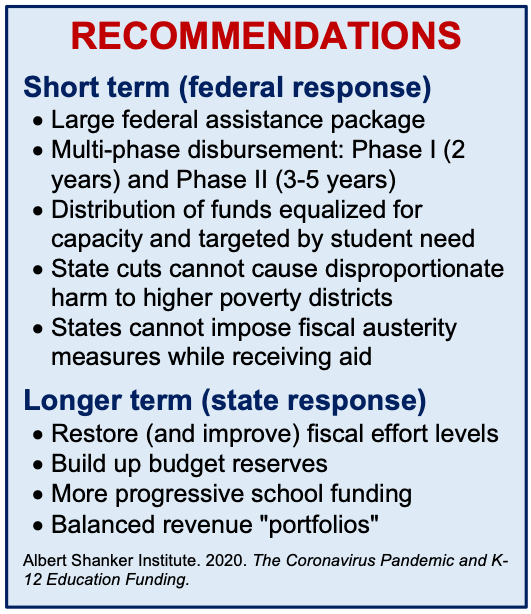The Coronavirus Pandemic and K-12 Education Funding
 The most terrible and lasting effects of the coronavirus pandemic will of course be measured in loss of life. But a parallel tragedy will also be unfolding in the coming months and years, this one affecting those at the beginning of their lives: an unprecedented school funding crisis that threatens to disadvantage a generation of children.
The most terrible and lasting effects of the coronavirus pandemic will of course be measured in loss of life. But a parallel tragedy will also be unfolding in the coming months and years, this one affecting those at the beginning of their lives: an unprecedented school funding crisis that threatens to disadvantage a generation of children.
It currently is difficult to make any precise predictions about the magnitude of the economic recession caused by the coronavirus pandemic, except to say that it has already started and it is likely to be severe. The revenue that funds public K-12 schools—almost 90 percent of which comes from state and local sources—will see large decreases. There will be cuts.
Making things worse, school districts in many states have yet to recover from the last recession, the so-called Great Recession, which officially began in late 2007 and devastated state and local education budgets. That is, many jurisdictions will be facing a possibly unprecedented funding crisis while they are still digging out from the last one.
Students in the senior class that will graduate this spring started kindergarten in fall 2007. They have spent most of their K-12 careers in schools either facing budget cuts or struggling to recover from them—this means, for example, fewer teachers and support staff, larger classes, and a narrower array of academic and extracurricular programs. The children who begin formal schooling in fall 2020 may be facing the same fate.
States and districts, however, are not powerless; there is a path forward. It will not prevent all damage, and it will require forward-thinking policymaking, but it can mitigate the severity and duration of the coronavirus pandemic’s impact on public school funding, as well as make states and districts better prepared for the next crisis.
In this report, using data from multiple sources, we describe the effects of previous recessions, particularly the Great Recession, on K-12 education finance, as well as the federal, state, and local policies and trends that mediated—for better or worse—the impact of these downturns on public school budgets. We then use these lessons to offer recommendations for short- and long-term responses to our current crisis.
Download the full report (PDF) or continue reading the executive summary below.
The impact of the Great Recession on education funding
The Great Recession of 2007-09, and its aftermath, was a disaster for K-12 education funding in the U.S., and a persistent disaster at that. We show that:
- Average state and local K-12 education funding to districts, adjusted for labor costs, dropped precipitously starting in 2008, and bottomed out in 2011, about 6 percent lower than its pre-recession level.
- The effects were particularly severe in higher-poverty districts.
- Some states had recovered by 2017 (the last year for which we have data), but most had not.
- The revenue and spending declines had real effects in schools, including a drop in teacher staffing ratios.
State policies and the "public school recession"
The large declines in revenue stemming from the Great Recession meant that K-12 education cuts were a certainty. Yet several state and local policy trends, many of them predating the Great Recession by years, may have exacerbated the severity and duration of the recession’s impact. We focus on four main factors, all of which inform our plan to address the current situation:
- A permanent decline in “fiscal effort”: The share of state economies devoted to K-12 education decreased between 2009 and 2012, and has not recovered.
- Steady erosion of state and local revenue: State and local revenue as a percentage of personal income, including tax revenue, has been declining for 25 years.
- Calibration of tax revenue sources: For years, many states had come to rely increasingly on local property tax revenue to offset cuts in state income and sales tax revenue. When the housing market crashed, property tax revenue declined for the first time, leaving states without their main means of shoring up education revenue.
- Non-progressive school funding: For the past 20 years, state and local public school funding has been neither progressive nor regressive (high- and low-poverty districts receive roughly the same funding), leaving high-poverty districts more vulnerable.
What we learned from the 2009 federal stimulus
The primary federal response to the education budget crisis caused by the Great Recession was the 2009-10 State Fiscal Stabilization Fund (SFSF), which was part of the American Recovery and Reinvestment Act (often called the “stimulus package”). This federal assistance was successful insofar as it gave states’ economies more time to recover, so that cumulative cuts were less severe. But two key aspects of the SFSF provide lessons going forward:
- The short duration of the aid (two years) was insufficient time for states’ economies to recover, creating a fiscal “cliff,” which necessitated drastic cuts being made all at once.
- Without federal guidance, and facing this fiscal cliff, many states simply cut state revenue to their districts in the same proportions as the depleted federal aid. This caused disproportionate harm to higher-poverty districts, which are more dependent on state revenue.
Recommendations for addressing the coronavirus recession’s impact on school budgets
Our recommendations, which are greatly informed by experience in past recessions, particularly the Great Recession (and the federal assistance package), are divided into two general categories: short-term (federal assistance); and longer-term (states’ responses).
Short-term recommendations (the federal response)
In March 2020, the federal government passed roughly $13 billion in K-12 education aid (part of the Coronavirus Aid, Relief, and Economic Security (CARES) Act to help with the coronavirus crisis’ fiscal impact. There is widespread agreement that additional federal K-12 education aid will be required. It is our position that this federal assistance must be distributed with a new approach. We recommend:
- A large federal aid package. Most basically, additional K-12 federal fiscal stabilization funds, over and above those provided by the CARES Act. These funds will need to be substantial.
- Multiphase allocation of federal aid. This new fund should be distributed in two parts or “phases,” beginning with a substantial allocation in years one and two (Phase I) and followed by a three- to five-year phase down effort (Phase II). This approach may even include flexibility to increase amounts in Phase II if the extent of the fiscal damage exceeds projections. Multiphase allocation will avoid the “fiscal cliff” problem of the 2009 federal stimulus.
- Equitable distribution of federal aid. This federal assistance program should be distributed in a manner that is equalized for local capacity and targeted according to student needs.
- Federal aid with “eligibility” requirements. To be “eligible” to receive federal assistance, states must abide by certain requirements and constraints:
- To the extent that states do impose cuts, they must be applied first (if not exclusively) to aid programs outside the equalized, needs-based formula. This will ensure a more equitable distribution of harm.
- For any cuts applied to state aid programs, states should not be permitted to cut a greater amount of per-pupil revenue to higher-poverty districts than they do to lower-poverty districts.
- States must not, during either Phase I or II, impose additional fiscal austerity constraints.
Longer-term recommendations (the state response)
Federal assistance will be crucial during the first few years of the coming recession, but this is also an opportunity to improve state school finance systems through this painful process. Education funding is primarily a state and local affair, and so truly sustainable solutions cannot take the form of federal aid with states continuing business as usual.

Accordingly, our longer-term recommendations focus on what states should be doing once their economies begin to rebound from the current recession (although much of the planning can and should begin immediately). We must approach our next period of prosperity more wisely.
- Increase or restore fiscal effort levels. States should, through federal policy incentives if necessary, move to restore their fiscal effort levels to those that prevailed prior to the Great Recession. States with low effort levels, particularly those that also have smaller economies from which to draw revenue, should increase effort. In most states, restoring or increasing effort levels will require tax increases and/or broadening of tax bases.
- Build up budget reserves. If states have money in reserve, and the flexibility to spend those funds as needed, it can be an enormous help in avoiding school layoffs and program cuts. As with fiscal effort, building reserves requires revenue, which generally means increasing effort (states should not build up reserves by cutting services).
- More progressive funding. Funding formulas should allocate education revenue progressively, with higher-poverty districts receiving more funding than lower-poverty districts. More progressive funding will ensure that higher-poverty districts, which are hit harder during downturns, are better equipped to recover from the current recession (and, indeed, finish recovering from the last recession).
- Balanced revenue “portfolios.” States should balance their state and local revenue configurations more strategically and less ideologically. Each of the three main sources of state and local tax revenue (sales, income, property) entails trade-offs, but a balanced “portfolio” can serve to hedge against risk of massive budget shortfalls during bad economic times while shoring up revenue streams during good times.
We acknowledge that virtually every component of this plan will be politically controversial for state and federal lawmakers alike. It bears reiterating, however, that we are entering this current pandemic-fueled recession having never recovered from the Great Recession. We are on the verge of this happening again, perhaps even worse this time. We cannot avoid a budget crisis, but we can attenuate its negative effects and shorten its duration. The alternative is to once again suffer funding cuts that threaten the quality of public schooling and equal educational opportunity over a period of many years.
The severity of the current crisis should, as in the human immune system, act as a wake-up call to strengthen public school finance not only so as to recover, but also to make us strong enough to withstand future crises.
*****
Download the full report (or view below)
Watch the video of the webinar
Publication date: April 24, 2020
Documents
